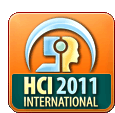T07: Designing Interaction for Ambient Intelligence Environments
Full Day Tutorial
Dr. Dr. Norbert A. Streitz (short bio)
Scientific Director, Smart Future Initiative, Germany
Objective:
The main objective of this tutorial is to make researchers and practitioners aware of the implications for interaction design caused by the increasing trend of embedding computation in everyday objects creating smart artefacts and ambient intelligence environments. Attendees will gain an overall understanding of designing for ubiquitous/pervasive computing and ambient intelligence and learn from examples in different applications domains (office, home, public spaces, leisure/games, smart cities). Tutorial attendees will learn about the state-of-the-art and how to realize the full potential of this new area in their current and future work.
Content:
The tutorial is divided in four major parts:
- Part 1: Introduction and conceptual frameworks
- Part 2: Ten claims for future developments
- Part 3: Application domains and design examples of selected projects
- Part 4: Twelve research lines of a future research agenda
"It seems like a paradox but it will soon become reality: The rate at which computers disappear will be matched by the rate at which information technology will increasingly permeate our environment and our lives" (Streitz & Nixon, 2005). This statement illustrates the important new challenges for the design of human-computer interaction. Computers used to be "primary" artefacts; now they become "secondary" artefacts moving into the background, disappearing from the scene, fusing with the environment, becoming invisible in the users’ perception. While disappearance is a prominent issue, smartness is equally relevant. Intelligent environments are constituted by smart artefacts, actuators, and sensors collecting data about the environment, the devices and the humans acting in this context.
The open design issues resulting from "disappearance" (e.g., requiring new affordances) and "smartness" (e.g., how to keep the human in the loop) are summarized in ten claims for future developments. They provide the template for discussing the implications for interaction design when embedding smart objects. Examples: It’s all in the environment: no need to carry devices, implicit vs. explicit interaction, system-oriented importunate smartness vs. people-oriented empowering smartness, privacy: legal and moral right vs. commodity and privilege, etc.
Increasingly, the future of our living and working environments has to be addressed beyond rooms and buildings at the level of urban environments. Digitalization of content and virtualization of social communication behavior is spreading from virtual worlds back into real environments enabling additional layers of experience, e.g., via augmented reality. Combining hybrid information and experience spaces with ubiquitous and pervasive computing in urban contexts constitutes what is being called 'smart hybrid cities'.
The tutorial will conclude with a presentation of 12 research lines for a future research agenda in the area of human-computer interaction and ambient intelligence based on the umbrella application scenario of smart hybrid cities.
Target Audience:
Introductory to Intermediate
Anyone interested in designing innovative systems and products, including researchers in cognitive and computer science, psychology, system designers, developers, information architects, interface designers, practitioners. It is intended for participants with some experience, so some background in user interface design is helpful.
Bio Sketch of Presenter:

Dr. Dr. Norbert Streitz (Ph.D. in physics, Ph.D. in psychology). Senior Scientist and Strategic Advisor with more than 30 years of experience in ICT. Founder and Scientific Director of the Smart Future Initiative (SFI) launched in January 2009. 1987 – 2008 at the Fraunhofer Institute IPSI in Darmstadt, Germany, as Deputy Director and Division Manager, e.g., of research division "AMBIENTE" – Smart Environments of the Future". Teaching at the Department of Computer Science of the Technical University Darmstadt for more than 15 years. Post-doc at UC Berkeley, visiting scholar at Xerox PARC and Intelligent Systems Lab, Tsukuba Science City. Published/edited 18 books and authored more than 120 papers. Steering Committee of the International Joint Conferences on Ambient Intelligence series. Chair of Working Group on "Ambient Computing and Communication Environments" of EU-funded InterLink project. Chair of Steering Group of EU-funded proactive initiative "The Disappearing Computer". Advisory Board of the Madeira Interactive Technologies Institute (M-ITI). Editorial Board of the Journal of Ambient Intelligence and Smart Environments (JAISE). Consultant and expert for the EC and other organizations. Keynote and tutorial speaker at scientific as well as commercial events in Europe, USA, South America, Malaysia, Singapore, Hongkong, China, Korea, and Japan.

